The eBay MIP is the Merchant Integration Platform (MIP) is a feed-based selling platform for small businesses and enterprise merchants.
If you own a small business or if you are an enterprise seller, you can start selling on eBay MIP now.
For WooCommerce shop owners, you just need to submit the WooCommerce product feed to MIP to create or maintain listings on eBay.
In this doc, I will show you how you can easily create your WooCommerce product feed for eBay MIP.
Follow these easy steps to generate a WooCommerce Product Feed for eBay MIP.
Before we start, I should let you know that it is a Pro feature of the Product Feed Manager for WooCommerce plugin, so you will require the Product Feed Manager Pro version to use this.
Step 1: Create New Feed & Map Your Product Attributes #
Go to your product feed dashboard.
Click on the Add New Feed button.
It will take you to the feed creation page.
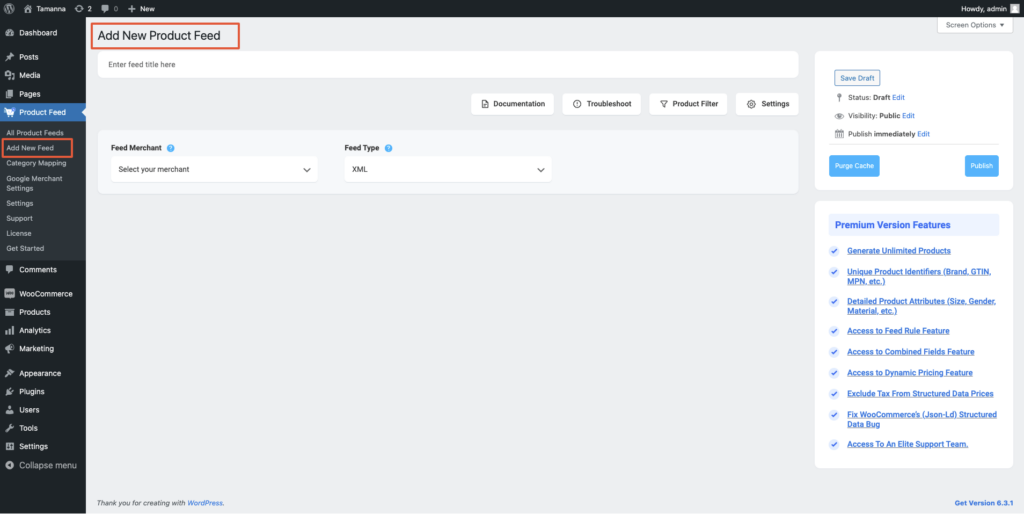
Now, here,
1. On top, you will get the option to add a title to the feed. Give your feed a name.
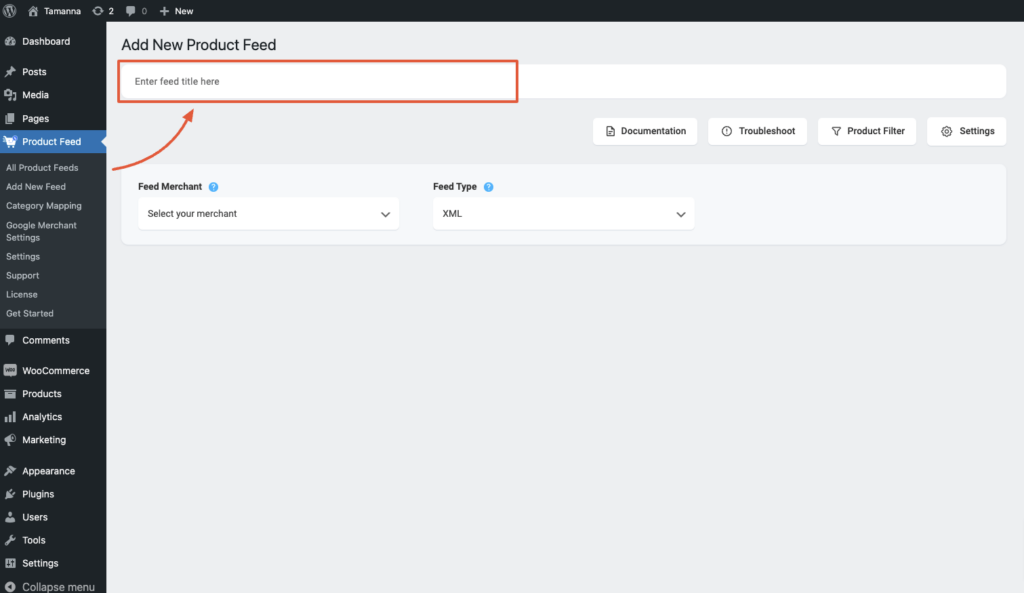
2. Just under the title, you will see an option to select your preferred merchant. Simply click on the Feed Merchant dropdown button and select your preferred merchant from the dropdown or you can search in the dropdown box.
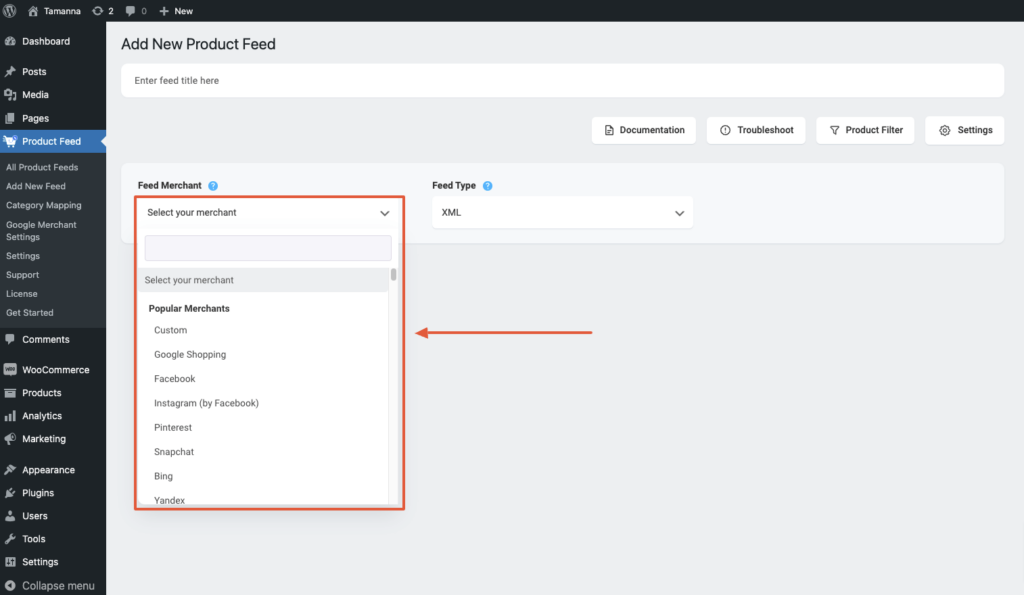
Select your preferred merchant, and all the required attributes will be loaded below.
Select eBay MIP from the dropdown list.

**Please note that eBay MIP only accepts XML and CSV feed file submission. However, the recommended format is CSV.
3. You can see that some of the attributes are already configured – their values are assigned properly, you can change the assigned values as per your need or you can keep them as it is.
However, you need to assign the rest of the attribute values manually.
For eBay MIP, you need to assign values for the following attributes:
- Localized For –
This attribute indicates the language your feed is presented in, and the country it will be sold on.
Since eBay MIP are in limited countries, here are the accepted values:
- en_US
- en_GB
- de_DE
- fr_FR
- es_ES
- en_CA
- en_AU
- de_AT
- it_IT
- ru_RU
- en_IN
- Additional Info –
- Brand –
This should be the Brand name of the product you are selling. If you are the manufacturer, you can set the type as Static and input your company name here.
If you have different brand names for different products, you will have to save the value in a custom field or product attribute and then use that value here.
**You may also use Perfect Brands for WooCommerce, which will make it easier to assign and use brand names.
- Condition –
Use this attribute to indicate the current condition of the product.
These are the accepted values for the condition:
- NEW
- NEW_OTHER
- NEW_WITH_DEFECTS
- MANUFACTURER_REFURBISHED
- SELLER_REFURBISHED
- USED_EXCELLENT
- USED_VERY_GOOD
- USED_GOOD
- USED_ACCEPTABLE
- FOR_PARTS_OR_NOT_WORKING
- Channel ID –
eBay lists products based on several channels it has for different countries.
The Channel ID is a unique identifier of the eBay MIP channel where you wish your products to appear on.
If you wish to sell on only one channel, then you may leave this column blank.
For multiple channels, you need to add a product multiple times and set the Channel IDs for your desired channels.
For example, if you sell in both USA and UK, then you will need to add the same products twice in two rows. For one, assign the Channel ID value as EBAY_US, and assign the Channel ID value as EBAY_UK for the other.
Then eBay will display the products on your desired eBay MIP channels.
Here is a list of the accepted Channel IDs for eBay MIP:
- EBAY_US
- EBAY_UK
- EBAY_DE
- EBAY_FR
- EBAY_ES
- EBAY_CA
- EBAY_AU
- EBAY_AT
- EBAY_IT
- EBAY_RU
- EBAY_IN
- EBAY_Motors
- Category –
eBay MIP has a category list of its own which you need to use to categorize your products on eBay. You must set this attribute according to their required taxonomy in order to get your submitted product feed approved.
They have a Category Lookup Tool where you can search for relevant category thread and collect the Category ID which you have to provide as the value.
For example, if you are selling a book in UK, which is an educational language coursebook, then on eBay Mip, it will fall under category – GBooks, Comics & Magazines > Textbooks Education & Reference > Language Courses.
You can collect its ID from the eBay Category Lookup Tool. In this case, the Product Category value is 11442.
- Shipping Policy –
Use the Shipping Policy to specify your product handling time, the shipping services you offer, and the shipping costs.
- Payment Policy –
Use the Payment Policy to specify how buyers can pay you, for example, through PayPal or credit cards.
- Return Policy –
Use Return Policies to specify whether you accept returns or not. If you accept returns, include your return conditions (such as the buyer will pay for the return shipping), etc.
These business policies have to be created by you on eBay. There you will be able to collect the respective policy IDs from your eBay account preferences and use them as the values when creating the product feed.
- Max Quantity Per Buyer –
You might wish to restrict the number of a certain product that a prospect can order. In that case, you may use this attribute so that a prospect won’t be able to order more than this many of the products within 10-days.
Here’s an example.
Let’s say you sell Hand-made Fancy Gift Cards. Now, let’s assume you have a rule of investing around 3 hours per day for a single customer and can create a maximum of 20 cards in 10 days for a particular customer.
Then you may add an attribute column ‘Max Quantity Per Buyer’ and assign the value ‘20’ so that a customer cannot order more than 20 cards within a span of 10 days.
- Strikethrough Price –
This attribute is there to help you create more attraction to prospects by adding a price that will be stricken through, to indicate that the current price is a discounted price.
Let’s say you are running a promotion to sell a Purse at $20, whereas the original price was $25.
Then you can set this attribute value as 25 to display that the old price was $25.
**You may use this feature even when you are not running a promotion. You can post the original price as the List Price, and then assign a higher value as a strikethrough price. But we strongly advise to use it only when you really run a promotion.
- VAT Percent –
This attribute is used to state the Value Added Tax percentage of the sale price. This is only necessary for the EU countries, though not mandatory.
Step 2: Feed Configuration #
1. Scroll up to the top and here, you will see that there are two options, Product Filter and Product Settings.
- Products Settings
- Product Filter
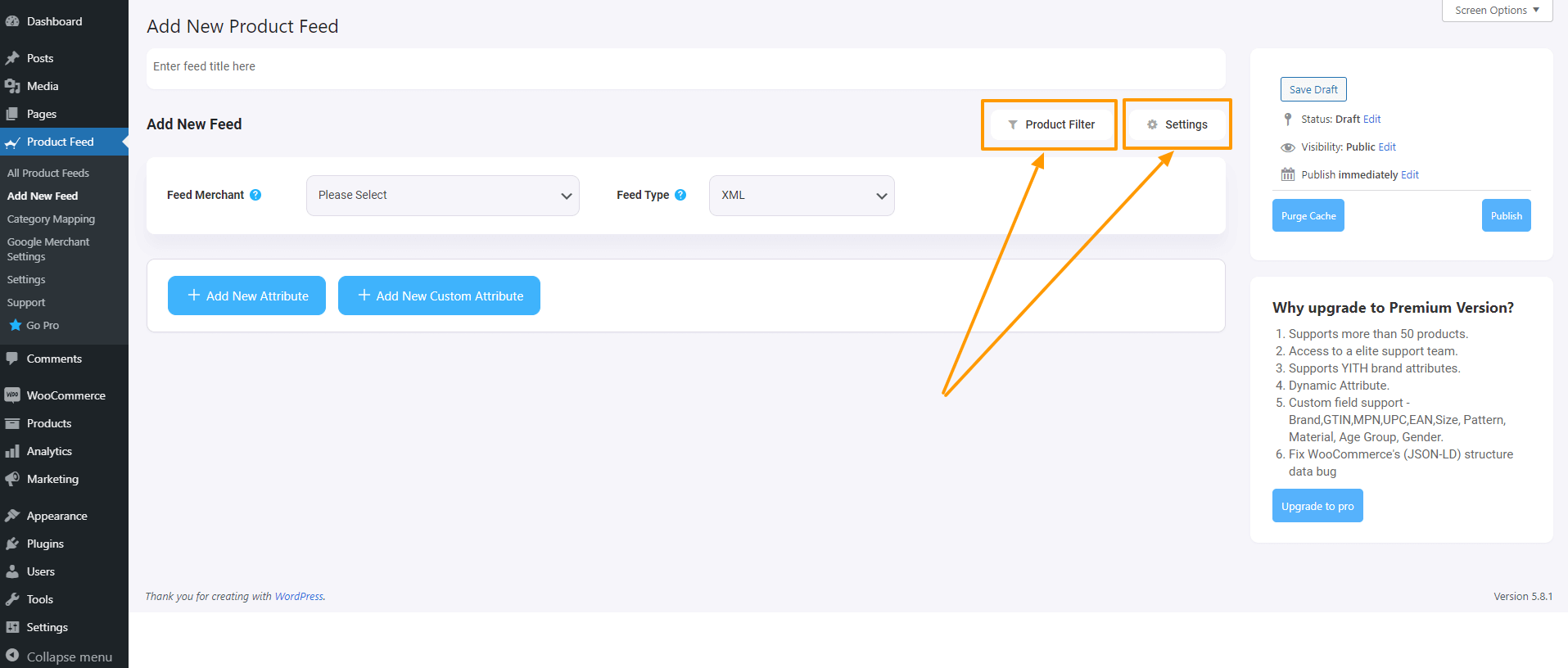
2. First, let us configure the features in the Product Settings. Click on the Product Settings button, and a drawer will open from the right side of the screen.
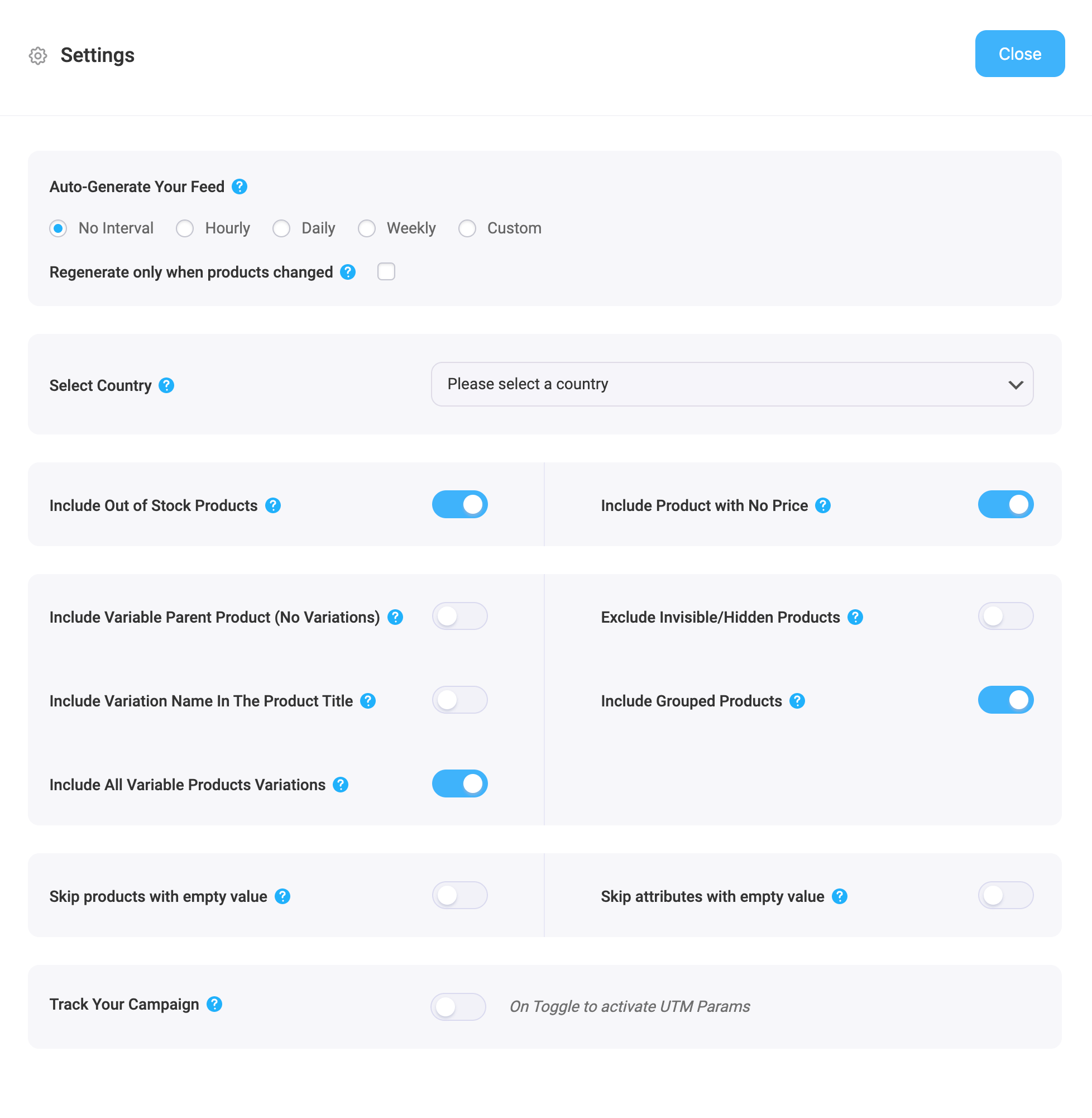
3. The first option you will see is Auto-Generate Your Feed.
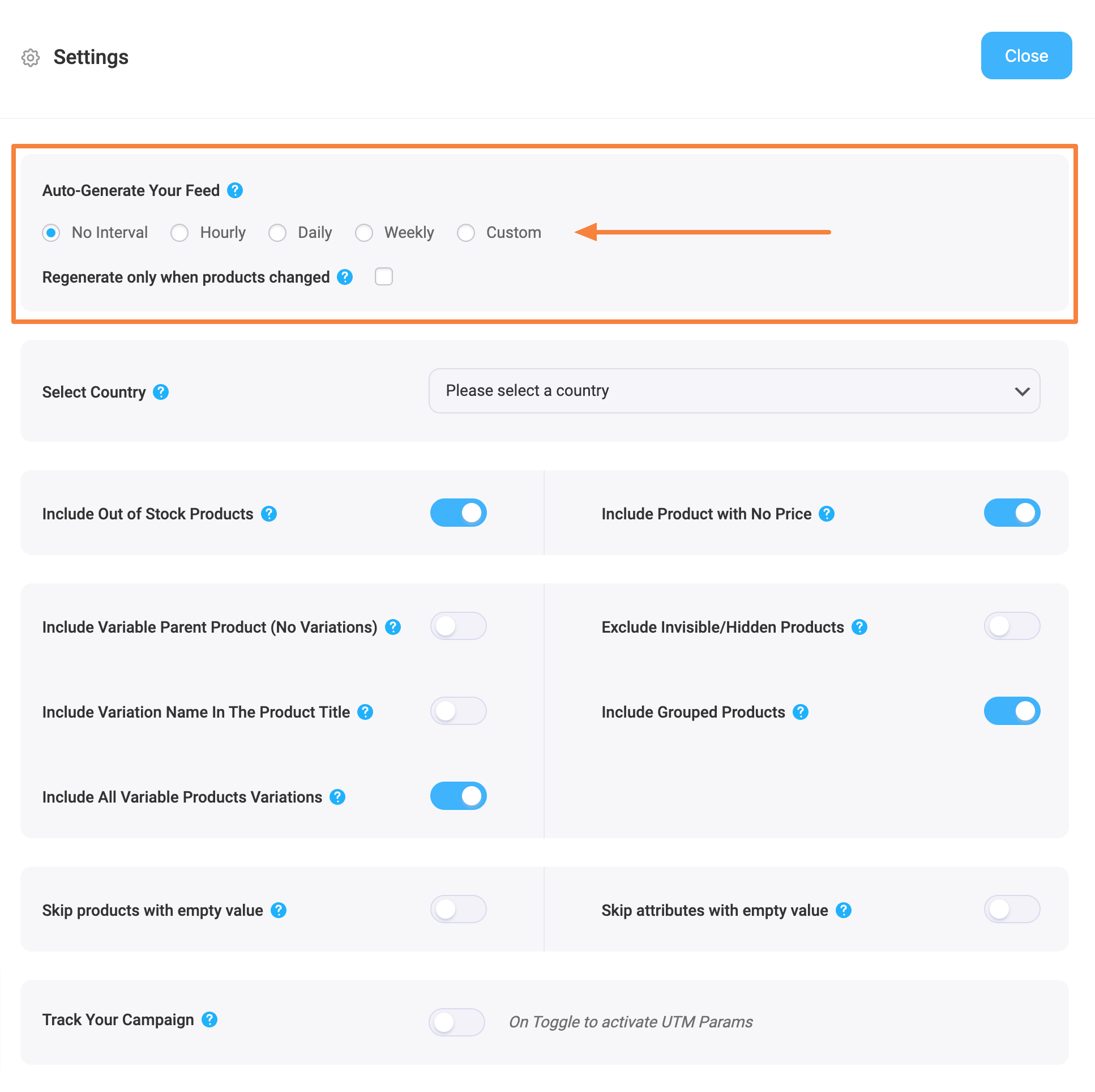
This option is used to schedule an auto-update of the feed after certain intervals. Choose an option to set an auto-update or leave it as “No interval” if you do not want to set an auto-update of the feed.
4. Next, use the following options as needed.
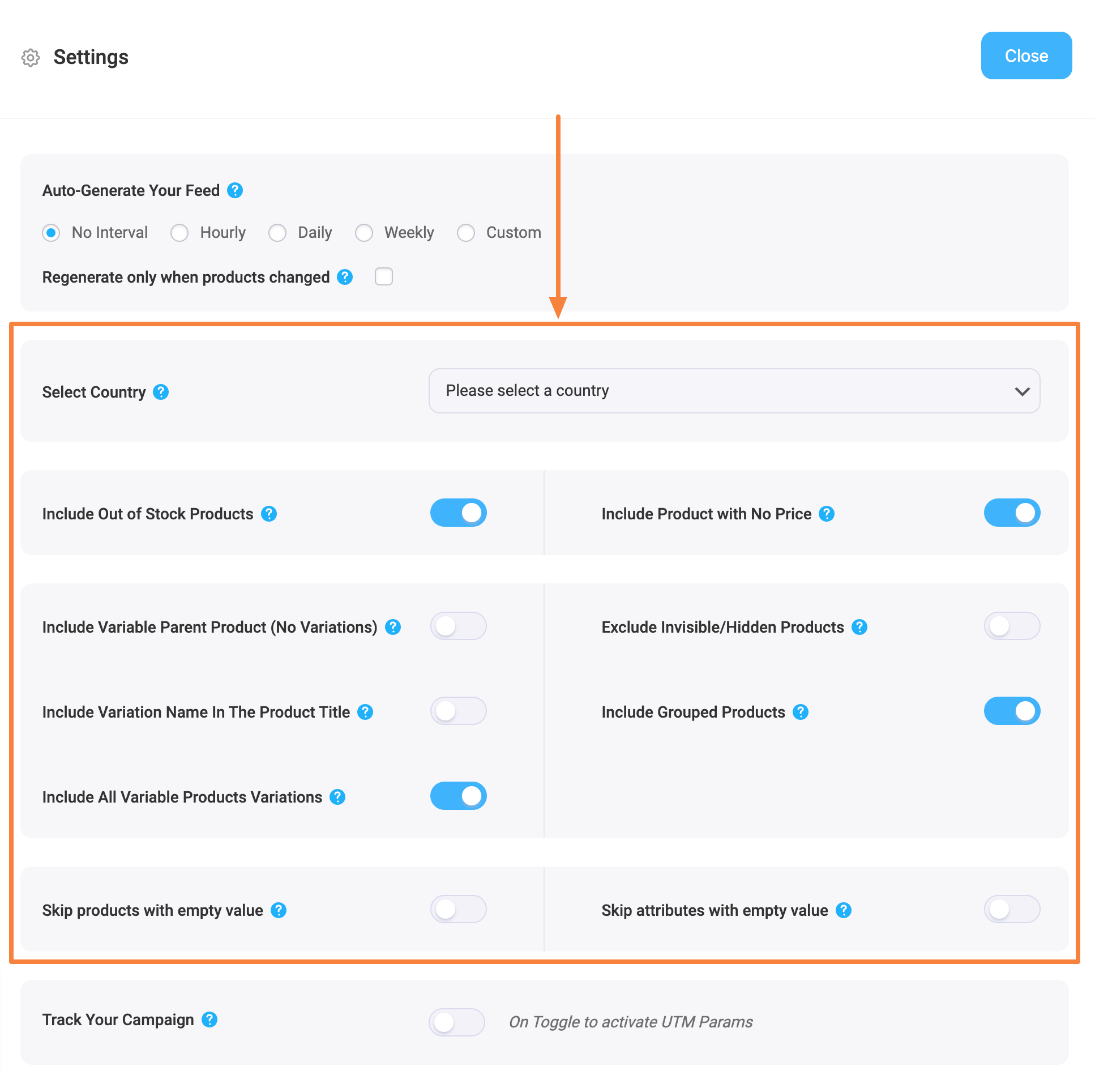
- Select Country/ Region
- Select a Region from this dropdown menu if you want to include the Shipping info to your feed. Once you select the region, you will have to insert the Shipping attribute to your feed to get the Shipping values.
- You can follow this doc to learn how to include the Shipping info in your feed.
- Include Out of Stock Products
-If you want to include the out of stock products, then you can enable the option.
-For this feed, let’s not use this option and keep its value as “No“. - Include Variable Parent Product (Without Variations)
-If you want to include the parent feed for variable products, then you can enable the option.
-Few merchants such as Google Shopping or Facebook doesn’t require you to submit parent products, however, there are many other merchants such as eBay MIP, that requires you to submit product products in the feed.
-For this feed, let’s not use this option and keep its value as “No“. - Include All Variable Products Variations –
-If you want to only include simple products to the feed and no variable products, then keep its value as “No“.
-If you want to submit both simple products and variable products to Google Shopping, then choose its value as “Yes“.
-Let’s use this feature, and mark it as “Yes“, for this feed. - Include Variation Name In The Product Title
-Few merchants such as Google Shopping, suggest you to add the variation term to the Product name in case you are uploading variable products, however, it is completely optional.
-So if you want to include the variant terms to the variable product names, then you can set its value as “Yes“.
-Let’s use this feature, and mark it as “Yes“, for this feed. - Include Grouped Products
-If you have Grouped Products, then it’s best to submit the parent product of the Grouped product you created.
-So you should mark this option as “Yes“. - Exclude Invisible/Hidden Products
-You might have certain products on your store that are marked as hidden or invisible on WooCommerce.
-If you want to generate feed for Simple products only, then you can mark this option as “Yes” to exclude invisible products from the feed.
-However, product variants are by default marked as Invisible on WooCommerce. So if you include variable products to the feed, then you should mark this as “No“.
-Since in this feed we are including product variants, so we will not use this feature and keep it as “No“. - Skip any attribute if the value is empty
-Enabling this feature will exclude any attributes of a product if the attribute value is missing.
-For this feed, let’s not use this option and keep its value as “No“.
5. At the bottom, you will find an option to Track Your Campaign (Analytics parameters).
Use this option if you wish to add analytics parameters to product links on your product feed so that you can keep track of the products’ performance on Google Shopping.
6. Now, close the drawer and click on the Product Filter option. A new drawer will open from the right.
On the top, you will get the option to use the Custom Filter or the Feed Rules feature (PRO).
And you will get the feed filter options from the Filter dropdown menu.
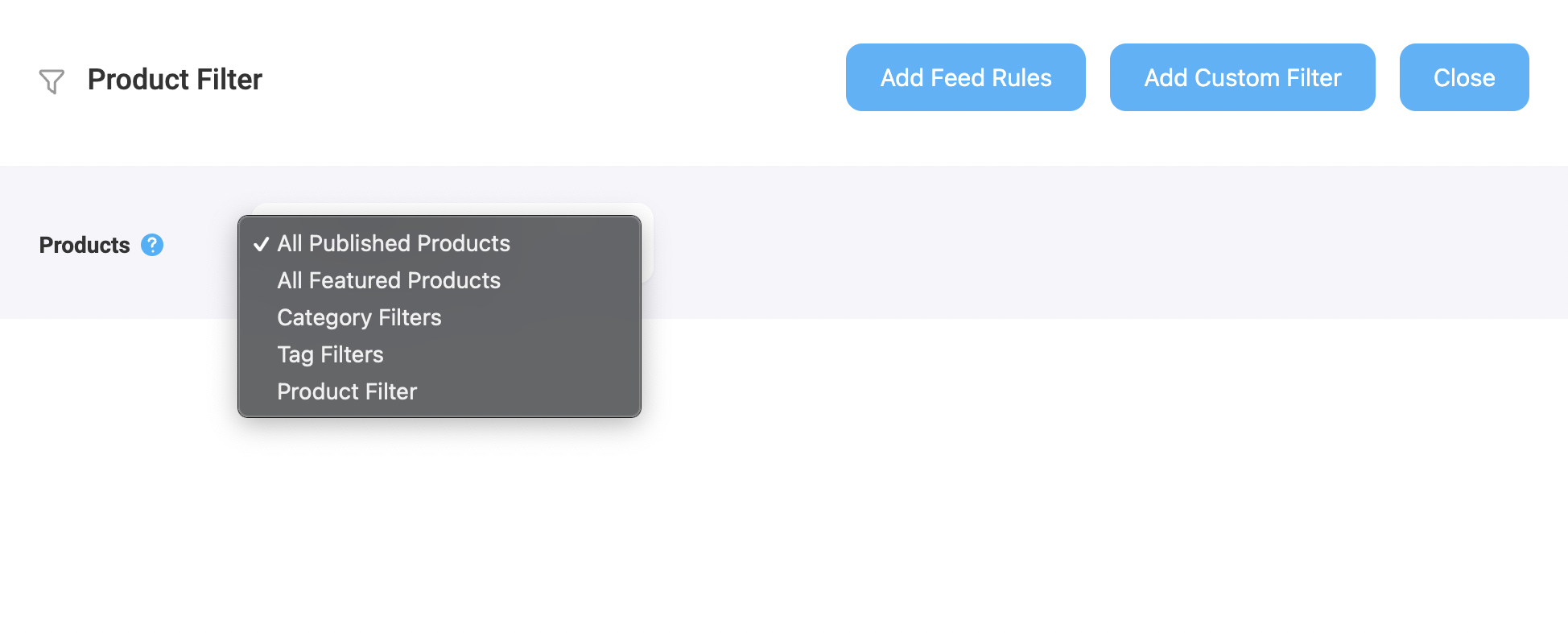
Choose the Products you want to include in the feed using any filter. “All Published Products” is selected by default
You may use any other filter options, Custom Filter, Category Filter, and Tag Filter, to include the products you require (or exclude the ones you do not want to include).
For a basic feed, you can keep it as it is.
Step 3: Publish WooCommerce Product Feed For eBay MIP #
Now, that you’ve configured your feed, it is time to publish the feed.
Scroll back to the top, and you will find a Publish button on the right.

Click on the Publish button, your feed will be generated.
Once your feed generation is complete, you will be able to view or download the feed.
That’s it. Your WooCommerce XML product feed for eBay MIP is generated.